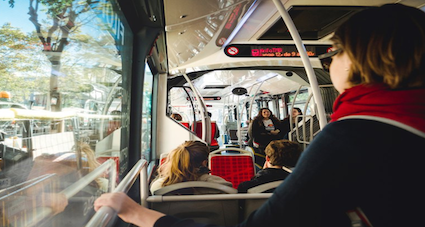Spain is said to have one of the better mass transit options in the world and it seems to be borne out by first hand experiences. City centre circular bus services – free in many cities. Electric tram lines between tourist cities – free on weekends. Intermodal transport system exchanges – brilliant, the only country I have seen which can seamlessly without interrupting traffic incorporate an underground bus terminal, train station and overground bus-stops with a roundabout – with the last on the periphery of the roundabout.
Bicycles and those small battery pusher 2-wheelers ride free on buses and trains, either hooked on the front or inside the cargo spaces below. Folding prams and folding bicycles? No problems. Likewise wheelchairs. And the best part is, the fares are skewed towards the benefit of the locals – and I met enough wealthy people who just did not own a motorcar.
These are the bus fares in a major Spanish city that I visited recently after decades. The first time I went there, we rented a car, and drove around without much ado and worry. This time around, apart from the much higher cost towards insurance that we as Indians were likely to be charged, was the sheer huge number of traffic rules and high penalties which dissuaded us from renting, and depending on public transport.
The most interesting part that I observe is how tourists (who pay 2 Euros) appear to subsidise residents, citizens, senior citizens and children. In effect, by the time the children have reached an age when they can buy or operate a personal motor vehicle, they end up riding the bus or the train. For personal transport, the monthly insurance alone will be much more than the cost of their 50-journeys per month ticket, with zero risk of traffic penalties.
Especially when it is so very easy to carry a small battery “pusher” or ordinary bicycle, again free for citizens, by bus or by train. Why would they buy a two-wheeler, then, when the bus fares look like this?
Tourist Single Fare – 2 Euro per trip
Tourist 10-trip Fare – 1.50 Euro per trip
Citizen-Resident 1-trip Fare – 0.80 Euro per trip
Citizen Non-Resident 1-trip Fare – 1.15 Euro per trip
Students 1-trip Fare – 0.45 Euro per trip
Citizen Pensioners/Seniors – 0.30 Euro per trip
Very Old Age – Free
Children upto 16 – Free
Citizens who make regular journey – get the following credits per month –
20 journeys Citizens/30 days = 13 Euro
50 journeys Citizens/30 days = 29 Euro
Unlimited journeys Citizen Seniors/30 days = 7 Euro
Nobody, not even employees of the transport companies when travelling off-duty, are entitled to a different fare. Or a free pass. All elected and selected representatives carry their pre-paid cards with them. The Chief of Police of the large town I was in happened to be sitting next to me, the only reason I knew was because his bodyguard was also there, and he paid for the journey because he was going to visit his late mother’s village. His bodyguard was exempted from buying a ticket because he was on duty.
Here in India, senior citizen’s discounts on trains have been unilaterally dropped, but free passes are issued to a variety of entitled categories. As for our elected and selected representatives buying tickets or paying tolls? Lage raho.
Public transport, especially electric buses, often known as “trolleys” because they run along fixed routes using power drawn from overhead wires using train-type pantographs, have been around in many countries for a long time – from after the first oil shock of the ‘70s. Pure battery buses can increasingly be seen now, too, especially at airports, ferry terminals and city – centres. And sometimes they can be as crowded as the ones we see in Indian cities. With climate change and global warming and hotter summers, they can get quite hot inside too, but then the entry and exit doors are all designed for double width entry and exit.
Incidentally, two of the most popular cars in Spain are the old first generation design of Suzuki Swift, sold as Suzuki Swift, and the first generation WagonR, sold as Opel Agila. Easy to maintain, and cheap to run, you see them all over the place. And yes, some of them are fitted with Indian brand name tyres too.
(Veeresh Malik was a seafarer. And a lot more besides. A decade in facial biometrics, which took him into the world of finance, gaming, preventive defence and money laundering before the subliminal mind management technology blew his brains out. His romance with the media endures since 1994, duly responded by Outlook, among others.)


